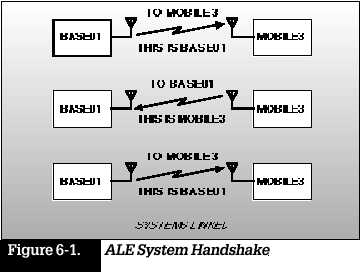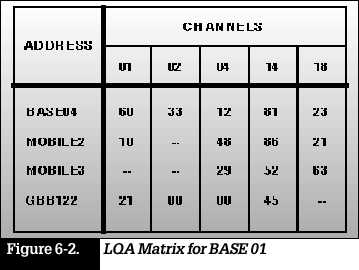
The constantly
changing properties of the ionosphere, as well as random noise and interference,
cause disruptions in HF communications. In the past, a skilled radio operator
was required to establish communications and to continually adjust operating
parameters. Today, this function is fully automatic. Harris RF Communications
provides adaptive radio systems,
pioneered
in the early ‘80s, that can react rapidly to changing propagating conditions
and use feedback from Real Time Channel Evaluation (RTCE) techniques to
select frequencies, adjust data rates, or change modulation schemes. Two
of the many adaptive processes are Automatic Link Establishment (ALE) and
Link Quality Analysis (LQA). Because of Harris’
previous
experience with adaptive radio technology, the company was asked to become
a member of the United States Military Standard Committee to develop the
ALE standard.
Automatic Link Establishment
ALE is a technique that permits HF radio stations to call and link on the best HF channel automatically without operator assistance. Harris pioneered the manufacture of adaptive communications equipment with AUTOLINK. In addition, Harris is a leader in the development of advanced ALE techniques that comply with MIL-STD-188-141A and FED-STD-1045A. (See Appendix A, Standards.)
Typically,
ALE systems make use of recently measured radio channel characteristics
(LQA data) stored in a memory “matrix.” The system works much like a telephone
in that each radio in a network is assigned an address (ID). When not in
use, each radio receiver constantly scans through its assigned frequencies,
listening for calls addressed to it. To reach a specific station, the caller
simply enters an ID just like dialing a phone number. The radio consults
its LQA matrix and selects the best available assigned frequency. (Further
expla-nation of the LQA matrix appears below.) It then sends out a brief
message containing the ID of the destination. When the receiving station
“hears” its address, it stops scanning and stays on that frequency. The
two stations automatically conduct a “hand-shake”
to confirm
that a link is established and they are ready to communicate (Figure 6-1).
The receiving station, which was completely silent, will typically emit
a ringing signal to alert the receiving operator of an incoming call. At
the conclusion of the call, one of the stations “hangs up,” a disconnect
signal is sent to the other station, and they each return to the scanning
mode.

Link Quality Analysis
An HF communications
system has a number of channels assigned to it. A system incorporating
LQA capability selects the best channel. Here’s how it works in an adaptive
system. At prescribed intervals, a station in a network will attempt to
link on each of its assigned frequencies and measure the signal quality
on each linked frequency. These quality scores are stored in a matrix.
When a call is initiated, the radio checks its “memory” to determine the
best quality frequency for the call to the desired station. It then attempts
to link on that frequency. If the link cannot be established, it will try
again on the next best frequency, and so
on, until
a link is established.

Figure 6-2
shows a simplified LQA matrix for station BASE01.
The channel numbers represent programmed frequencies, and the numbers in the matrix are the most recent channel-quality scores. Thus, if an operator wanted to make a call from BASE01 to MOBILE03, the radio would attempt to call on channel 18, which has the highest LQA score. When making multi-station calls, the radio selects the channel with the best average score. Thus, for a multi-station call to all the addresses in the matrix, channel 14 would be selected.
Adaptive Enhancements
Adaptive radio
technology is further enhanced by the use of computer controllers, which
permit modem data rate selection based on channel conditions, optimum antenna
choice, automatic adjustment of transmitted power level, automatic nulling
and elim-ination of interfering signals, and selection of modem modulation
and coding schemes. The benefit is that these adaptive schemes are largely
automatic and improve communications without oper-ator intervention. Thus,
the requirement for an operator with high
technical
knowledge has been significantly reduced.
SUMMARY
• Adaptive
radio technology permits modern HF radio systems to adjust automatically
to changing propagation conditions.
• Automatic
Link Establishment (ALE) makes it possible for HF radios to connect without
operator assistance.
• Link Quality
Analysis (LQA) is a method of assessing channel quality, so that connections
occur on the best channel/ frequency.
• Other automatic
adaptive techniques are available.